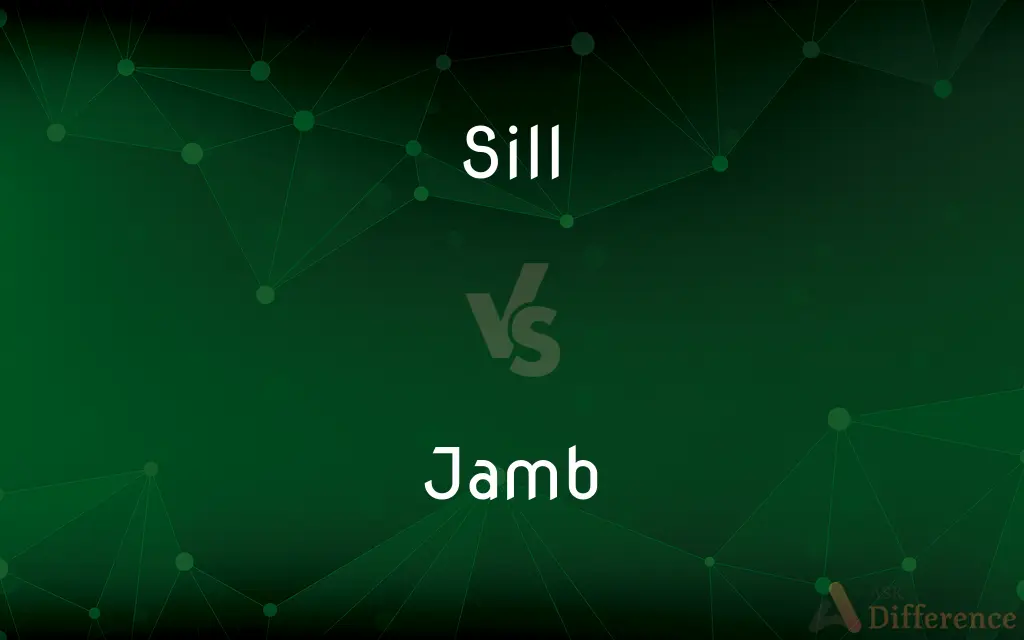Sill vs. Jamb — What's the Difference?
By Urooj Arif & Fiza Rafique — Updated on March 24, 2024
A sill is the horizontal bottom part of a window or door frame, whereas a jamb is the vertical side component of a window or door frame.

Difference Between Sill and Jamb
Table of Contents
ADVERTISEMENT
Key Differences
The sill, also known as a windowsill or doorsill, serves as the base of a window or door frame, providing structural support and often extending into the room to form a ledge. In contrast, a jamb is the vertical element that runs along the sides of a window or door frame, supporting the structure and housing the mechanisms for opening, closing, and locking.
Sills are designed to repel water away from the interior, with their outer edge usually sloping downwards to prevent water from pooling or entering the building. On the other hand, jambs are tasked with bearing the weight of the structure and facilitating the smooth operation of the window or door, including the alignment and securing of the fixture.
In terms of materials, sills can be made from wood, stone, concrete, or other durable materials that can withstand exposure to the elements. Jambs, while also made from similar materials, require strength and rigidity to support operational stresses and may include additional components like hinges or strike plates.
While the sill forms a horizontal boundary at the bottom, jambs create the vertical boundaries on the sides, working together to frame the window or door. Both are essential for the structural integrity and functionality of the opening, but they play distinctly different roles in the assembly.
The aesthetics of a sill can vary, from simple and functional designs in utility settings to ornately carved stone in more decorative applications. Jambs, while often more utilitarian in appearance, can also feature decorative elements, especially in historical or high-end architectural designs.
ADVERTISEMENT
Comparison Chart
Position
Horizontal bottom part of a frame
Vertical side components of a frame
Function
Supports the base, repels water
Supports weight, houses operational mechanisms
Material
Wood, stone, concrete
Wood, metal, stone, with hardware elements
Design Role
Can be decorative, often features a slope
Primarily structural, may include decorative elements
Associated With
Windowsill for plants, doorsill in entryways
Door jambs for hinges, window jambs for sashes
Compare with Definitions
Sill
Designed to slope outward to prevent water ingress.
The sill was carefully crafted to direct rainwater away from the window.
Jamb
Supports the structural weight and facilitates operation.
The sturdy jambs ensured the door opened smoothly.
Sill
The horizontal base component of a window or door frame.
She placed potted plants on the windowsill.
Jamb
The vertical side component of a window or door frame.
The door jamb included a recess for the locking mechanism.
Sill
May feature decorative designs in certain architectures.
The ornate sill reflected the building's historical significance.
Jamb
Can incorporate decorative elements in certain styles.
The intricately carved jambs added to the grandeur of the entrance.
Sill
Often extends into the room, creating a ledge.
The wide windowsill served as a cozy seating area.
Jamb
Houses elements like hinges or strike plates.
The carpenter aligned the hinges with the door jamb.
Sill
Can be made from various materials for durability.
The stone sill added an elegant touch to the facade.
Jamb
Made from materials that offer strength and rigidity.
The hardwood jambs complemented the room's aesthetic.
Sill
A horizontal member that bears the upright portion of a frame.
Jamb
A jamb (from French jambe, "leg"), in architecture, is the side-post or lining of a doorway or other aperture. The jambs of a window outside the frame are called “reveals.” Small shafts to doors and windows with caps and bases are known as “jamb-shafts”; when in the inside arris of the jamb of a window they are sometimes called "scoinsons." A doorjamb, door jamb (also sometimes doorpost) is the vertical portion of the door frame onto which a door is secured.
Sill
A windowsill.
Jamb
One of a pair of vertical posts or pieces that together form the sides of an opening, as for a door, window, or fireplace.
Sill
(Geology) A sheet of igneous rock formed by the intrusion of magma between existing strata.
Jamb
A projecting mass or columnar part.
Sill
A breast wall; window breast; horizontal brink which forms the base of a window.
She looked out the window resting her elbows on the window sill.
Jamb
Either of the vertical components that form the side of an opening in a wall, such as that of a door frame, window frame, or fireplace.
Sill
(construction) A threshold; horizontal structural member of a building near ground level on a foundation or pilings, or lying on the ground, and bearing the upright portion of a frame; a sill plate.
Jamb
(mining) Any thick mass of rock that prevents miners from following the lode or vein.
Sill
(geology) A stratum of rock, especially an intrusive layer of igneous rock lying parallel to surrounding strata.
Jamb
Synonym of jambeau.
Sill
A threshold or brink across the bottom of a canal lock for the gates to shut against.
Jamb
(transitive) To fix or attach a jamb to.
Sill
(anatomy) A raised area at the base of the nasal aperture in the skull.
The nasal sill
Jamb
The vertical side of any opening, as a door or fireplace; hence, less properly, any narrow vertical surface of wall, as the of a chimney-breast or of a pier, as distinguished from its face.
Sill
The inner edge of the bottom of an embrasure.
Jamb
Any thick mass of rock which prevents miners from following the lode or vein.
Sill
(UK) A young herring.
Jamb
See Jambes.
Sill
The shaft or thill of a carriage.
Jamb
Upright consisting of a vertical side member of a door or window frame
Sill
Silly.
Sill
The basis or foundation of a thing; especially, a horizontal piece, as a timber, which forms the lower member of a frame, or supports a structure; as, the sills of a house, of a bridge, of a loom, and the like.
Sill
The shaft or thill of a carriage.
Sill
A young herring.
Sill
Structural member consisting of a continuous horizontal timber forming the lowest member of a framework or supporting structure
Sill
(geology) a flat (usually horizontal) mass of igneous rock between two layers of older sedimentary rock
Common Curiosities
What function does a door jamb serve?
A door jamb is the vertical component of a door frame, supporting the door, housing hardware like hinges, and contributing to the door's alignment and security.
Can a sill be part of a door?
Yes, a sill can be part of a door frame, referred to as a doorsill, providing a threshold and sealing the bottom of the doorway.
How do sills protect against water?
Sills are designed with a slope that directs water away from the window or door, preventing water from entering the building.
Are jambs necessary for all windows and doors?
Yes, jambs are essential components of window and door frames, providing structural support and housing mechanisms for the operation of the window or door.
Can the material of a sill differ from that of the jamb?
While they can be made from the same materials for consistency, the material of a sill can differ from that of the jamb based on functional and aesthetic requirements.
What is a windowsill?
A windowsill is the horizontal base part of a window frame, often extending inside to form a ledge.
How are sills and jambs measured for installation?
Precise measurements are taken of the opening width and height, ensuring the sill and jambs fit snugly and provide proper support and sealing.
What happens if a sill is not properly installed?
An improperly installed sill can lead to water ingress, structural damage, and may affect the window's or door's functionality.
Do sills and jambs require maintenance?
Like other building components, sills and jambs require maintenance to ensure their longevity and functionality, especially when exposed to harsh weather conditions.
Can sills and jambs be customized?
Yes, both sills and jambs can be customized in terms of size, material, and design to match specific architectural needs and personal preferences.
Is it common to decorate sills and jambs?
Yes, especially in certain architectural styles, sills and jambs can feature decorative elements that contribute to the building's aesthetic.
Can jambs be replaced if damaged?
Yes, damaged jambs can be repaired or replaced, though the process may vary in complexity depending on the structure and type of window or door.
How do jambs contribute to the security of a door?
Door jambs can house security features like strike plates and deadbolts, contributing to the overall security of the door.
What is the difference between an interior and exterior sill?
Exterior sills are designed to repel water and are exposed to the elements, while interior sills may serve more decorative purposes and are not subject to weathering.
How do sills and jambs work together in a frame?
Sills and jambs work together to form the perimeter of a window or door frame, providing structural support, sealing against elements, and contributing to the aesthetic of the opening.
Share Your Discovery

Previous Comparison
Efficacy vs. Efficiency
Next Comparison
Pepper vs. CapsicumAuthor Spotlight
Written by
Urooj ArifUrooj is a skilled content writer at Ask Difference, known for her exceptional ability to simplify complex topics into engaging and informative content. With a passion for research and a flair for clear, concise writing, she consistently delivers articles that resonate with our diverse audience.
Co-written by
Fiza RafiqueFiza Rafique is a skilled content writer at AskDifference.com, where she meticulously refines and enhances written pieces. Drawing from her vast editorial expertise, Fiza ensures clarity, accuracy, and precision in every article. Passionate about language, she continually seeks to elevate the quality of content for readers worldwide.














































